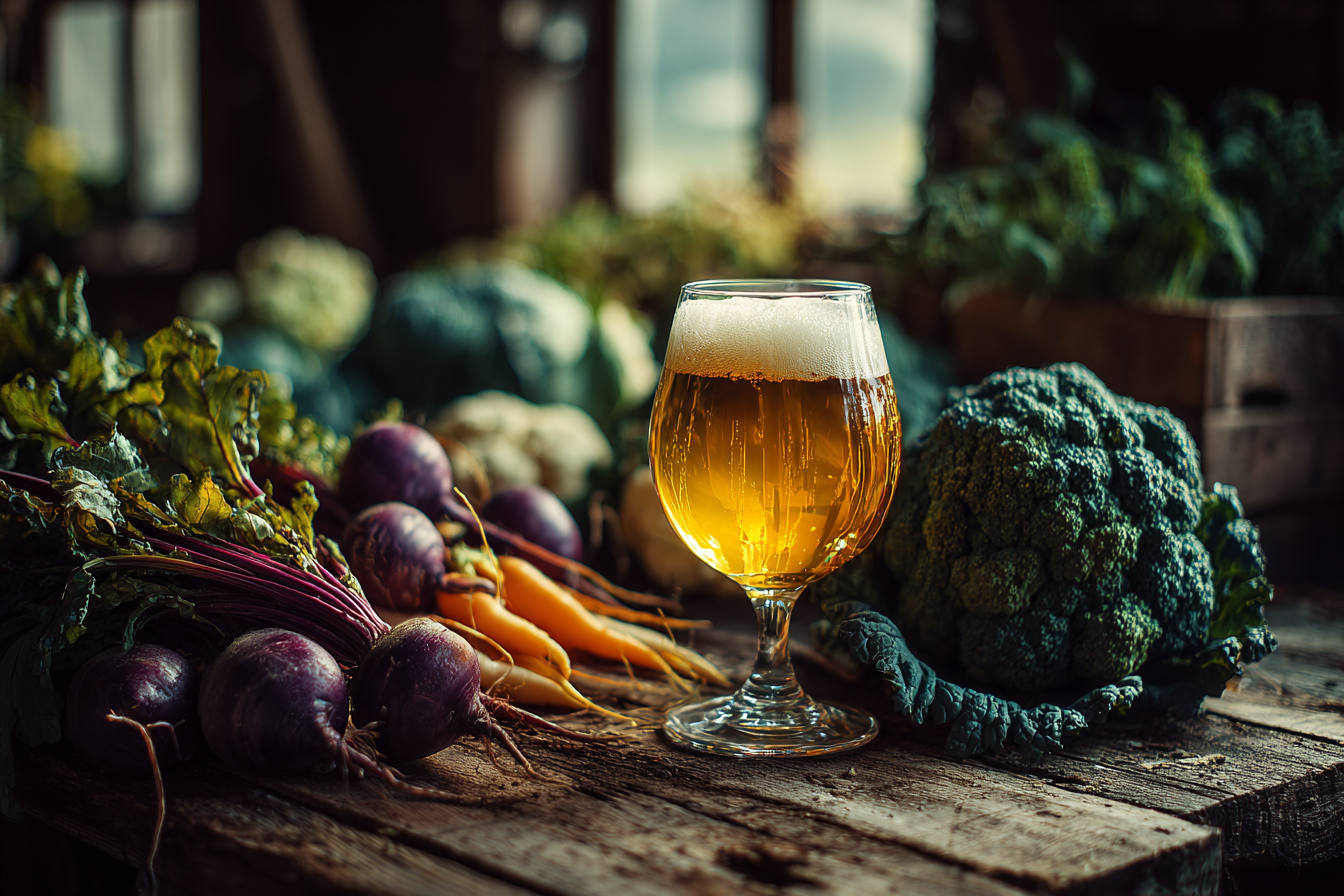If you’re looking to brew a beer that stands out from the usual malt and hops profile, vegetable beer recipes offer a creative and flavorful alternative. Incorporating fresh vegetables into your brewing process not only adds unique tastes but also presents a way to celebrate seasonal and garden-fresh ingredients. From the sweetness of carrots to the earthy notes of beets and the subtle spice of pumpkin, vegetable beers are an exciting frontier for homebrewers eager to experiment. Let’s explore the world of vegetable beers and how you can craft your own delicious brews at home.
Why Vegetable Beer Is Gaining Popularity
Vegetable beers have been around for centuries, but in recent years, their popularity has surged as homebrewers and craft breweries alike look for new ways to innovate and delight the palate. The trend toward farm-to-table and locally sourced ingredients plays a big role, encouraging brewers to incorporate fresh vegetables that vary by season and region.
Beyond just flavor experimentation, vegetable beers offer a sustainable brewing option. Using garden or surplus vegetables can reduce waste and add complexity to your beer that’s simply not achievable with traditional ingredients. Plus, the visual appeal and novelty factor make vegetable beers a hit at tastings and social gatherings.
Benefits of Using Vegetables in Beer Brewing
Adding vegetables to beer isn’t just about novelty — there are tangible benefits that make it worthwhile:
- Unique Flavors and Aromas: Vegetables bring a wide range of flavors, from sweetness and earthiness to bitterness and spice, allowing brewers to craft distinctive profiles.
- Enhanced Nutrient Content: Vegetables contribute vitamins, minerals, and antioxidants, which can subtly enhance beer’s healthful qualities.
- Seasonal Variety: Incorporating vegetables lets brewers experiment with flavors that reflect the season, creating a dynamic brewing calendar.
- Creative Flexibility: The ability to blend different vegetables opens up endless recipe possibilities.
- Storytelling: Using locally grown or garden-harvested vegetables adds a personal narrative to your beer.
Essential Ingredients and Equipment for Vegetable Beer
Before you dive into brewing your vegetable beer, it’s important to gather the right ingredients and equipment to ensure a smooth process and great results:
- Base Malt: Pale malt or pilsner malt works well as the foundation for most vegetable beers.
- Hops: Choose hops that complement the vegetable’s flavor. Mild, floral, or citrusy hops often pair nicely.
- Vegetables: Fresh and preferably organic vegetables such as carrots, beets, pumpkins, squash, or even asparagus.
- Yeast: A neutral ale yeast is generally best to let vegetable flavors shine, but experimenting with saison or wheat yeast can add complexity.
- Water and Sanitation Supplies: Clean water and rigorous sanitation are crucial for quality beer.
- Basic Brewing Equipment: Brewing kettle, fermenter, airlock, siphon tubing, bottling supplies, and hydrometer.
In addition to these essentials, you might want to have a food processor or grater handy to prepare vegetables properly, ensuring their flavors extract well during brewing.
How to Brew Vegetable Beer: Step-by-Step Guide
Crafting a vegetable beer requires a thoughtful approach to balance the malt, hops, yeast, and your chosen vegetables. Here’s a step-by-step guide to help you get started:
1. Prepare Your Vegetables
Wash and peel vegetables as needed to remove dirt or any undesirable flavors. Chop or grate them finely to maximize their surface area for flavor extraction. For root vegetables like carrots and beets, roasting or steaming before adding to the wort can intensify their sweetness and complexity.
2. Mash and Boil the Wort
Start with your malt base and mash as usual to convert starches into fermentable sugars. After sparging to collect the wort, bring it to a boil and add hops according to your recipe. The boil is the time to add vegetables that benefit from sterilization, such as root vegetables, which can be added in the last 10-15 minutes of the boil.
3. Add Vegetables During Fermentation (Optional)
Some vegetables impart different flavor profiles when added after the boil. For example, delicate greens or squashes can be added directly to the fermenter or in secondary fermentation using sanitized bags or hop spiders. This method preserves more of their fresh, vegetal aroma.
4. Cool the Wort and Pitch Yeast
After boiling, cool the wort quickly to yeast-pitching temperature and transfer it to the fermenter. Pitch your yeast and seal with an airlock.
5. Primary Fermentation
Allow fermentation to proceed as usual. Temperature control is important to avoid off-flavors and maintain the vegetable character.
6. Secondary Fermentation and Aging
If you added vegetables later, this stage will help extract subtle aromas and smooth the beer. Give the beer time to mature before bottling.
7. Bottling and Conditioning
Package your beer with priming sugar and allow it to carbonate at room temperature, then cold condition for a few weeks for optimal flavor development.
Popular Vegetables for Brewing and Their Flavor Profiles
Different vegetables bring distinct characteristics to beer. Here are some favorites among vegetable brewers:
- Carrots: Impart a natural sweetness and slight earthiness, with a vibrant orange color that livens up the beer visually.
- Beets: Offer deep earthy flavors, a subtle sweetness, and vivid ruby hues. They work well in darker ales and stouts.
- Pumpkins: Classic for fall brews, pumpkins add mild sweetness, a smooth mouthfeel, and pair beautifully with spices like cinnamon and nutmeg.
- Squash (Butternut, Acorn): Provide subtle sweetness and creaminess, excellent in lighter ales and saisons.
- Asparagus: For the adventurous, asparagus contributes an intriguing grassy and vegetal note, usually added late in fermentation.
- Tomatoes: Can add umami and tartness, often blended modestly into lighter beer bases.
- Celery Root (Celeriac): Delivers a nutty, herbal character that complements earthy malt profiles.
Balancing Flavors and Managing Fermentation
Vegetables can bring delicate or bold flavors that must be balanced carefully to avoid overpowering the beer. Here are some tips:
- Start with smaller vegetable additions; you can always increase amounts in future batches.
- Pair vegetables with hops that complement or contrast their flavor for complexity (e.g., floral hops with carrots).
- Use yeast strains that enhance subtle vegetable flavors without masking them.
- Maintain strict fermentation temperature control to prevent unwanted off-flavors.
- Consider adding spices or herbs that harmonize with the vegetable’s taste profile.
Careful taste-testing during fermentation can help you adjust timing and ingredient ratios for optimal results.
Troubleshooting Common Challenges in Vegetable Beer Brewing
Brewing with vegetables can introduce unique challenges, but most are manageable with some care:
- Off-Flavors: Vegetables that are added too early or in large quantities can produce grassy, bitter, or vegetal off-notes. Avoid excessive vegetable amounts and consider adding some during secondary fermentation instead of the boil.
- Fermentation Issues: High sugar content in some vegetables may cause excessive fermentation or stuck fermentation. Adjust malt amounts accordingly and monitor yeast health.
- Bitterness or Astringency: Root vegetables, if not prepared properly, can add undesirable bitterness. Roasting or steaming before addition can help.
- Color Instability: Some vegetables, like beets, may cause fading or cloudiness over time. Use stabilizers or consume the beer fresh.
- Sanitation: Vegetables can introduce microbes, so thorough cleaning and sometimes pasteurization before adding them are essential.
Serving and Pairing Your Vegetable Beers
Serving vegetable beers provides an opportunity to elevate the tasting experience through thoughtful food pairings:
- Carrot or Pumpkin Ales: Pair excellently with roasted poultry, mild cheeses, or dishes flavored with warming spices like cinnamon and clove.
- Beet-Based Beers: Complement root vegetable dishes, earthy mushrooms, or even dark chocolate desserts.
- Squash or Butternut Brews: Enjoy with creamy pastas, soft cheeses, or nut-based dishes.
- Vegetal or Herbal Beers: Pair with salads, grilled vegetables, or fresh fish dishes for contrast and freshness.
Serving these beers slightly chilled, but not too cold, allows the vegetable nuances to come forward. Consider using glassware that preserves the beer’s aromas, such as tulip or goblet-style glasses.
Embrace Creativity with Your Vegetable Beer Recipes
Exploring vegetable beer recipes opens an exciting world of brewing innovation and sensory discovery. Whether you’re using garden harvests or exploring new ingredient combinations, vegetable beers let you celebrate nature’s bounty in a truly delicious way. With a bit of practice and patience, you’ll be able to craft unique brews that surprise and delight friends and family alike. So grab your favorite vegetables, gather your brewing gear, and start creating your own slice of garden-inspired beer magic today.







